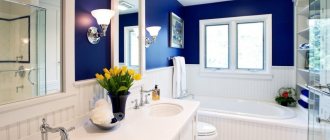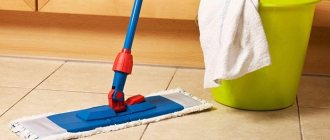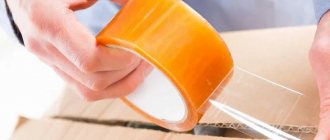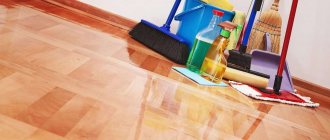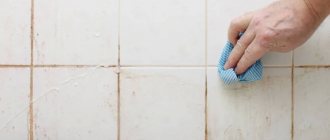Today, floor tiles are a popular coating that is valued by users for its practicality, high durability, and attractive appearance. Caring for it does not require much effort, which makes this material indispensable for finishing kitchens and bathrooms. But if you don’t take care of the tiled surface in a timely manner, then over time the dirt will penetrate deep into the tile and it will be difficult to remove it. In order to know exactly how to wash tiles on the floor, it is advisable to familiarize yourself with the most popular detergents, as well as traditional methods of cleaning such floor coverings. Subsequently, this will allow you to choose the most suitable option for yourself.
Why do stains appear on the floor?
The main problem with tiled flooring is the appearance of foreign marks after cleaning. This happens for the following reasons:
- fat has not been previously removed from the surface;
- the base was washed with hard water;
- excessive use of detergent;
- the cloth used was poorly wrung out;
- The water was not changed during the cleaning process.
If you take into account the above-described nuances when carrying out the cleaning process, then there will most likely not be any stains left on the surface of the floor base.
Equipment required for cleaning
In everyday life the following are used for cleaning:
- broom;
- rag;
- water;
- container for liquid;
- detergent.
For thorough cleaning use:
- detergents;
- mops;
- brushes.
It is important to choose the right rag with which to wash the floor. The range offers a choice of rags from the following materials:
| Material | Advantages | Flaws |
| Cotton | Durable and quickly absorbs moisture | Short service life |
| Viscose | Absorbs water well Suitable for removing small fluff from the floor durable | Not resistant to high temperatures. Cannot be used with cold water. |
| Microfiber | Absorbs water well and remains almost dry after squeezing. | Not suitable for removing greasy marks and stains |
| Cellulose | Thanks to the structure, they become rigid after drying, which prevents the proliferation of microbes Absorbs water well Polishes surfaces Leaves no streaks | Short service life |
How to wash properly
Cleaning a tiled floor properly is not difficult at all. In order for the tiles to simply shine clean later, it is enough to adhere to the following algorithm of actions:
- First of all, clean the surface using the dry method. This can be done using an ordinary broom or vacuum cleaner.
- Using highly effective detergents, perform wet cleaning.
- Add shine to the base.
Important! After completing each stage, you need to carefully inspect the floor in order to detect untreated areas in time. This will save you from having to redo the whole job all over again.
Mop or hands
It doesn’t matter how you decide to wash the floor - with a mop or with your hands - you must follow the rules described above. The result will be achieved in both cases. But how to work more conveniently? Is it possible to wash floors by hand without streaks? Here you decide for yourself, focusing on the pros and cons described in the table.
Table - Features of washing floors with a mop and by hand
| How to wash floors | pros | Minuses |
| Hands | — Good for your figure (more calories are burned); — no need to spend money on a mop and attachments for it; — convenient to wash baseboards and corners; - the result seems to be of better quality; — heavy dirt can only be removed manually | — It takes more time; — it is difficult to treat hard-to-reach places under furniture; — it’s inconvenient to work with gloves, and without them the manicure will deteriorate; - there is a load on the back, arms and knees |
| mop | — Cleaning goes faster; — no load on the back, arms and knees; — it’s convenient to treat the floor under furniture; - hygienic; - if the mop has an automatic spin, your hands are not exposed to detergents | — A good mop is expensive; - skirting boards, corners and stubborn stains still have to be handled manually; - if you just need to quickly refresh “prominent places”, it’s more difficult to maneuver between carpets and furniture with a mop |
Use of special detergents
Often, floor tiles are washed using various special products. The choice of the latter should be taken responsibly. After all, most of them have a similar cleaning effect, but some nuances are observed. Before choosing the right composition for yourself, it is recommended that you familiarize yourself with the most popular products.
Silit
Designed for cleaning kitchens and bathrooms, it has excellent cleaning properties at an affordable price. This chemical composition helps to get rid of even old stains, destroys harmful bacteria, and perfectly disinfects the surface being treated.
Milit
A concentrated product created specifically for cleaning kitchens, produced in the form of a spray. It perfectly removes dirt on all types of kitchen surfaces. Additionally, economical consumption and affordable price allow you to significantly save your budget.
Sanitol
Convenient packaging and the presence of a spray bottle ensure economical application of the substance to the base. In this case, no time is required for preliminary preparation. In addition, it is worth noting that the composition does not have a strong odor. The only disadvantage of sanitol is its relatively high cost.
Selena
This product is used for complex cleaning. It allows you to completely rid the surface of greasy stains. To wash dirty tiles you need:
- Dilute the chemical composition in a small amount of water.
- Treat contaminated areas with the resulting liquid.
- Wait about five minutes.
- Remove greasy deposits with a rag.
Mister proper
An extremely popular product among housewives. It is in great demand due to:
- versatility;
- affordable price;
- high quality dirt cleaning;
- no streaks after cleaning.
Hedgehog
A budget-friendly product for removing various contaminants. Among its main advantages are:
- low price;
- sufficient efficiency;
- speed of removal of difficult stains.
In the production of such a product, excessively harmful ingredients are used, which is considered its significant drawback.
Important! When working with chemicals (even if they are non-toxic), you must use personal protective equipment.
Disinfect and wash with potassium permanganate
This method is suitable for removing traces of whitewash from walls, baseboards, ceramic tiles, and dark linoleum. Categorically not suitable for light-colored floors: potassium permanganate will color them dirty brown. You should not try the method on varnished surfaces, as strong stains will remain.
Cleaning procedure:
- Add potassium permanganate powder little by little into a bucket of warm water and stir thoroughly. You should get a bright crimson color.
- They wipe the floor.
- They pass through with clean water, removing any remaining whitewash and permanganate.
Traditional methods
If you are unable to purchase an expensive special cleanser or do not want to use toxic drugs, you can use home remedies. As a rule, they are less efficient, but at the same time they are environmentally friendly. In practice, such recipes are often used.
Vinegar
Regular acetic acid makes an excellent cleaning solution. Cooking method:
- Mix a liter of water with 90 ml of table vinegar.
- Pour the liquid into a spray bottle.
- Treat the stain.
- Rinse off the applied composition with clean water.
- Wipe the surface dry.
Attention! Vinegar essence cannot be used to make a cleanser (due to its high concentration). Food vinegar (9%) is most suitable.
https://m-strana.ru/articles/chem-otmyt-gruntovku-so-stekla/
Ammonia
Making a cleaning composition for floor tiles is very simple. To do this you will need:
- Prepare two liters of an aqueous solution of ammonia. The latter will only need one tablespoon.
- Pour liquid into the sprayer.
- Treat contaminated areas.
- Wait five minutes.
- Wipe the surface with a dry cloth.
Lemon acid
To clean tiles, you can use citric acid instead of vinegar. It needs to be diluted in warm water or poured onto a moistened sponge, then rubbed into the contaminated base.
Important! In addition to removing dirt from a tile floor, citric and acetic acids additionally disinfect it: they get rid of dangerous mold and other harmful organisms.
Chalk
It is recommended to treat floor coverings made of glossy tiles with ordinary chalk. Procedure:
- Mix chalk and water to form a mushy consistency.
- Apply the prepared mixture to the surface of the tile.
- Remove the resulting layer along with the dirt.
Advice! To make the tiled floor shine, it additionally needs to be wiped with paper.
Chlorine
For those who can tolerate the unpleasant chlorine smell, it is recommended to try the following recipe:
- Dilute a tablespoon of chlorine in 1 liter of water.
- Treat the tiles with the prepared liquid. In this case, it is advisable to use a sprayer.
- Wait about ten minutes.
- Wipe the surface with a clean cloth.
As practice shows, a chlorine solution can easily cope with even stubborn stains. It is extremely important to use rubber gloves when cleaning.
Melamine sponge
Excellent for removing dirt from glass, tiles, metal, and parquet. Before you start cleaning, you need to moisten it well, and then treat the contaminated area of the floor covering. It is especially effective to use melamine sponge in places where chemicals cannot be used and moisture is not allowed.
Steam cleaner
A very simple, extremely easy to use household appliance. It is best suited for cleaning tiles in the bathroom and kitchen. Under the influence of the hot steam released by the device, the dirt instantly lags behind the base. At the same time, no traces remain on the surface at all. If you strictly adhere to the manufacturer's recommendations, there will most likely not be any major difficulties with cleaning.
How to remove plaster, traces of whitewash
It is better to wipe off dried plaster stains as dry as possible. If there are tiles on the floor, just scrape it off with something, but try not to scratch it. For softer surfaces—linoleum—soak with acidified water (add vinegar) and scrub off little by little. If it is too difficult, any product with active acids will help to clean the floor. Among the most affordable are Toilet Duckling and similar products for the toilet or bathroom. But first read the composition - hydrochloric or any other acid should be indicated there. Just don’t try it on linoleum, parquet or laminate. Most likely, the coating will be damaged. If there is scrap material, test the product on it. After testing, is there any damage or discoloration? Try cleaning the plaster from the floor with this product.
How to wash linoleum after repair - with simple means: water + vinegar + dishwashing detergent
To clean the floor from putty or plaster, first try diluting a capful of the found acidic product in a small amount of water (a liter or one and a half). Apply the solution to the stain and wait a few minutes. Let's try to scrub it off. It helped - great. No, we're trying to increase concentration. Particularly persistent ones can be treated with an undiluted product. But if it doesn’t help, most likely you need to look for another remedy.
You can try softening plaster or putty stains with kerosene. Drop a couple of drops and wait, then try to wipe it off. But remember that it is better not to apply kerosene to laminate and linoleum.
When working with acids or kerosene, try to breathe “to the side.” Literally. The acid and kerosene evaporate and the vapor enters the lungs and can cause severe coughing. If you breathe long enough, it can even cause poisoning. In general, open the windows, ventilate and be careful. Whitewash, putty and other repair compounds are removed in the same way.
How to wash flooring without streaks
To ensure that no traces are observed on the tiles after the cleaning process is completed, you must:
- First of all, clean the seams and joints in the corners of the room. Detergent is applied to the latter and left for three to five minutes. Then these areas are treated with a brush, and the remaining cleaning substances are removed with a rag.
- Wash the floor with a special product, after diluting it with water.
- To ensure that the tiles always remain in perfect condition, they should be washed regularly (several times a week).
To care for tiled floors, we recommend purchasing a special mop. Every stain that appears must be washed off in a timely manner. The latter will not allow dirt to penetrate inside the ceramic material and complicate future cleaning.
Mistake 2: You can do without a broom
Sometimes, instead of sparkling clean, the floor becomes even dirtier. This is because dust and debris, when in contact with water, turn into terrible stains.
Tip: Therefore, before you start washing, use a regular broom or broom. Sweep the floor thoroughly, paying special attention to corners and hard-to-reach areas of the room where dust and debris most often accumulate.
This will help you avoid spreading excess dirt while mopping the floor. And in order not to raise dust, moisten a broom or broom with water.
How to clean tile floors from stubborn dirt
If you do not clean the tiles after each new stain, the dirt will dry out and then it will be difficult to remove.
A good remedy for getting rid of grease and rust is an aqueous solution of vinegar (1:1). When using a spray, it should be applied to a dirty surface, then wiped with a microfiber cloth.
Advice! When cleaning tiles, it is unacceptable to use used dish sponges: they can damage the floor base.
Using oil and vinegar
After the first and second washing, stains are usually still visible, and it happens that residents have to wash off the old, deeply ingrained whitewash inherited from the previous owners of the house or apartment. In this case, wash the floors with micellar water:
- Pour vegetable oil into warm water (10 tsp per 10-liter bucket).
- Stir well and wash, replacing the emulsion with fresh one as it gets dirty.
The last whitish washouts are removed with water and vinegar:
- if there was a struggle with the new whitewash - 2-3 tbsp. l. on a bucket of water,
- if with the old one - 100 ml per bucket.
The rag is generously moistened and washed, constantly rinsing and changing the water if necessary.
Advice Even with a weak vinegar solution, you need to work in ventilated areas or with the hood on.
Method for wooden floors
Wood is a material that is especially sensitive to caring agents, and oil emulsion is contraindicated for such a coating. Dried whitewash can be washed with vinegar and subsequent “replenishment”:
- Vinegar (5 tbsp per bucket) or ammonia (10 tbsp per 10-liter bucket) is poured into warm water.
- Clean the floors several times.
- Wipe dry.
- Soak in glycerin to restore the structure (1 tbsp per 250 ml of water).
How to remove mold
In addition to limescale or dirt, the tiled floor often needs to be cleaned of mold that has formed in the area of the seams. In such a case, you need to prepare a cleaning composition from the following components:
- soda – 1/2 cup;
- vinegar - 1/4 cup;
- ammonia – 1/3 cup;
- water - 7 glasses.
The solution needs to be poured into a container with a spray bottle, then thoroughly treat the affected areas. After some time, the surface should be wiped with a pre-moistened cloth.
Additionally, a mixture of the above ingredients will disinfect the tile surface and get rid of bitumen stains and paint (water-based).
A small praise to “Domestos”
After repairs, you have to remove contaminants of various origins, and it is convenient to use universal products. There are quite a few of them on the market; we will mention Domestos Pine Fresh. It is highly rated by many users; the product removes whitewash well, along with other stains.
Instructions:
- The liquid is diluted in water, maintaining a ratio of 2 tbsp. l. funds for 5 l.
- Use the prepared solution to wipe all surfaces with stains and streaks.
- Remains of the product are removed with a cloth soaked in clean water.
“Mr. Muscle”, “Mr. Proper” or specialized household chemicals will also help to wash off the limescale.
Renovation is an update, but also a lot of work. To prevent the new walls and snow-white ceiling from spoiling the mood with stains on the floor, doors and windows, you need to start cleaning right away. There are quite a few ways to quickly get rid of traces of whitewash - choose the one that suits you best and enjoy an updated, refreshed environment and cleanliness.
How to clean fat
Vinegar and baking soda will help thoroughly clean floor tiles from grease accumulations. If the latter are mixed and then applied to a heavily contaminated surface, then after a quarter of an hour all the dirt will dissolve. You just need to clean it with a damp cloth.
In addition, you can get rid of grease on tiles with the help of lemon. It easily removes stubborn stains from many food items. The dirt should be wiped with a lemon slice or treated with juice. Subsequently, even stubborn dirt will dissolve.
If there are pets in the house
If a dog or cat marks the territory, then regular washing will not get rid of the smell. Special tools will help here:
- Potassium permanganate. Dissolve 5-6 drops in a glass of water, soak a sponge in the solution and wipe the stain. Then wash the floor with cold, clean water and wipe dry.
- White. The product contains toxic chlorine, so it is better to dilute bleach with water in proportions of 1:10. Use the resulting solution to wipe the contaminated area of the floor and wash with clean water. Wear gloves when working.
- Washing powder. Dilute a couple of tablespoons of the product and thoroughly wash the entire floor in the room. To consolidate the result, dilute a glass of 95% medical alcohol in a bucket of water and wipe the floor again.
Rules of care
To avoid having to take drastic measures when cleaning tiled flooring, you must follow these useful recommendations:
- The joints must be treated with silicone sealant. This will prevent mold from forming between the tiles.
- Do not use abrasives to clean tiles. The latter can ruin the floor and deprive it of its beautiful shine.
- To disinfect tiles, it is recommended to use products containing bioenzymes.
- In order for the tiled surface to shine, it must be treated with a special product immediately after washing.
- Rough floors should be washed especially carefully: dirt often gets stuck in the cracks and serves as a breeding ground for germs.
Advice! Cleaning floor tiles cannot be put off for too long. Otherwise, contaminants will penetrate into the structure of the material, and it will not be easy to remove them later.
We wash linoleum after repair
Using the means listed above, linoleum can also be washed. It is better to exclude kerosene - not all types of coating can tolerate it. You cannot use gasoline or ammonia - not all types of linoleum are friendly with them either. These solvents, along with dirt, can also dissolve the protective coating, so we don’t take risks.
To clean linoleum after repair, you need a lot of rags
But you can add laundry soap and turpentine to the list. It is better not to use more aggressive means.
Is it possible to wash laminate flooring with bleach?
Washing laminated planks with bleach or bleach is strictly prohibited. Chlorine corrodes the outer protective layer of the plates, they lose color. Sometimes the shape becomes deformed, and the floor covering needs to be completely replaced.
If chlorine accidentally gets on the floor, you should immediately remove it with a dry cloth, rinse the area with warm water, and check whether the color of the coating has changed. If the damaged area is highlighted, it must be carefully replaced with new panels. Therefore, when buying laminate, make sure in advance that after the repair there is a sufficient number of new “boards” left to replace the damaged ones.
Where to begin
Before you start cleaning, change into your “home clothes.” Your “outfit” should be soft, practical and not restrict movement. Wipe the soles of the slippers so that you don’t leave dust marks on the clean surface. Further:
- ventilate the rooms - and also remove dust from furniture and carpets;
- free up space - you should roll up and remove carpets, raise chairs, floor vases, lamps and other oversized interior items;
- wipe the legs - these are the parts of the furniture that “catch” dust, hair, dirt;
- remove debris with a wet broom or vacuum cleaner.
What should I rub on the tiles to make them shine?
Procedure:
- Remove large debris, as rubbing the surface can scratch the tile.
- Fine dust should be removed with a dry cloth (if you have a mini vacuum cleaner or steam generator, also use it).
- After this, you can begin to cleanse from dirt or grease; for this, choose any suitable product.
- Rub the tiles with a special alcohol-containing polish or a dry cloth (until the desired shine and gloss appears).
- If you wash off the whitewash, you will have to wash the surface several times, changing the water each time and rub it with a dry, clean cloth.
Universal methods for stubborn stains
By remembering a few universal techniques, you can easily deal with stains of any complexity on all types of coating.
- Dirt. The easiest way to wash it off is with washing powder or Fairy dishwashing detergent.
- Fat. To remove greasy deposits from the floor, mix baking soda and sunflower oil to the consistency of thick sour cream. Rub the floor with the resulting mixture and let stand for 10-15 minutes. And then, sweep away the remaining soda with a broom and wash with cold water.
- Mold. Washing floors with bleach can defeat it. The use of bleach requires compliance with proportions, the use of protective equipment and mandatory ventilation of the room. Add 10 g of bleach to 5 liters of water. The floor is washed with the windows open, when there are no children or animals in the house.
To make your floors shine, use table vinegar when washing - two large spoons per 10 liters of water. And for a pleasant aroma, you can add one or two drops of essential oil to the bucket.

